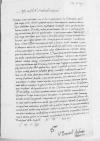Discessum tuum insperatum nemo est ⌊hic⌋ et apud ⌊caesarem⌋ et ⌊Ferdinandum⌋, qui non ferat iniquo animo, etiam hi, quibuscum non fuere tecum intima nec familiaria commercia. Taceo ⌊Valdesium⌋, a quo si amaris sique observaris et tamquam pater coleris, qui te melius sciat, habemus neminem. Et si ubique versaris per ora hominum, illic tamen apud tam gratum ⌊tuique amantissimum iuvenem⌋ cotidie videris et quasi praesens audiris. Dolerem profecto et ego cum reliquis, quod nos reliqueris sine te solos, nisi tuae felicitati me invidere arbitrareris, qui et dulcem patriam colis, et tamquam in portu nostra naufragia e specula securus spectas. Verum id non dolere non possum plurimum, quod discesseris a nobis clanculum et quasi te subripueris amicis tuis ac praesertim mihi, qui tibi sum addictissimus; cui tunc primum est nuntiatum abisse te, cum an rediisses ad nos nondum habueram exploratum multoque prius discessum tuum quam reditum noverim. Et quia id non temere a te factum arbitror, non audeo reprehendere, quod mihi magnopere displicuit. Voluissem enim te visitare, salutare, comitari omnique et humanitatis et benevolentiae munere prosequi, meum animum propensissimum erga te meamque servitutem erga ⌊reginam serenissimam⌋ reserare idque muneris tandem obire, quod me decet. Quo fit, ut quod praesenti non licuit, nunc remotis fucis verbisque phaleratis, sub quibus plerumque et mendaciis et adulationibus non deest locus, me tibi etiam absenti totum dedam operamque meam, officium et industriam quantacumque est pollicear, in quibus si quam fortasse quandoque spem collocaveris, scies me tibi amicissimum et ⌊communi dominae⌋ asseclam fore perpetuum servumque fidelissimum. Ceterum cupio mihi a ⌊serenissima regina⌋ in re honesta satisfieri, a qua id meis litteris postulavi, quas (ut arbitror) tibi legendas praeferet ⌊maiestas sua⌋. Et si illam negaturam mihi, quod aequum est, non ambigo, scio tamen, quantum amicorum valeant honestae commendationes et propterea te rogo, meum negotium tibi assumas et iure amicitiae ⌊communem dominam⌋ ita mihi concilies, ut ignorem, re impetrata, cui ego maiores gratias sim habiturus, illine, quae satisfecit optatis meis, an tibi, qui ut mihi satisfieret, laborasti. Et quemadmodum uterque vestrum multo minus praestabit mihi quam valeat elargiri, ita ego gratissimi beneficii accepti memor, conabor utrique multo plus retribuere, quam suppetant vires meae. Sique id fieri non poterit, undequaque curabo saltem, ne animus meus voluntasque propensissima despiciatur neque in minimo quidem vel ab invidis reprehendatur. Et optime ac felicissime valeat Dominatio Vestra.

